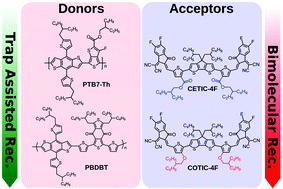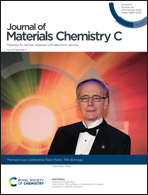Design of narrow bandgap non-fullerene acceptors for photovoltaic applications and investigation of non-geminate recombination dynamics†
Abstract
A new narrow bandgap non-fullerene electron acceptor was designed, synthesized, and characterized for near-infrared organic photovoltaics. This acceptor was compared to a structurally similar compound with systematically modified side chains, and a series of solar cells were fabricated, employing the common donor polymers PTB7-Th and PBDBT. The devices exhibited charge generation over a wide spectral range and power conversion efficiencies up to 8.1%. The non-geminate recombination dynamics were investigated and quantified via a combination of capacitance spectroscopy and transient open-circuit voltage decay measurements. The reduction of the bandgap results in increased bimolecular recombination losses, while solar cells composed of PBDBT were afflicted by stronger monomolecular, i.e. trap-assisted, recombination losses that ultimately caused the lower power conversion efficiencies of the respective devices. The latter observation could be correlated to less ordered blend film morphology.

- This article is part of the themed collections: Editor’s Choice: Organic Photovoltaics and Celebrating Tobin Marks’ 75th Birthday


 Please wait while we load your content...
Please wait while we load your content...